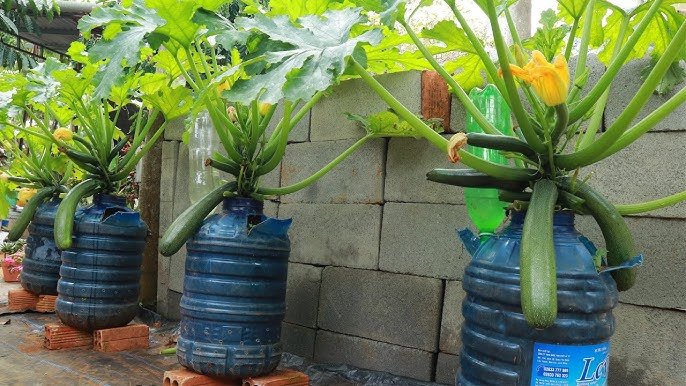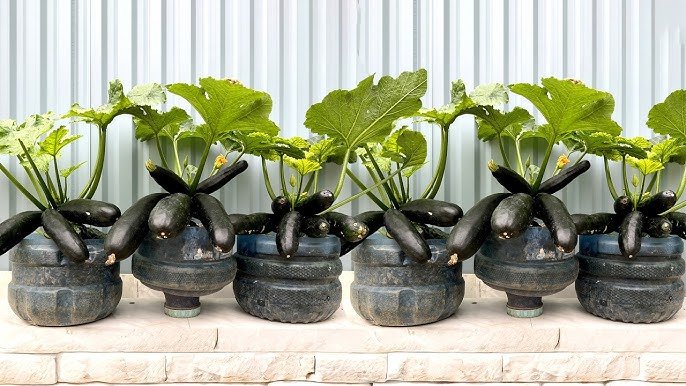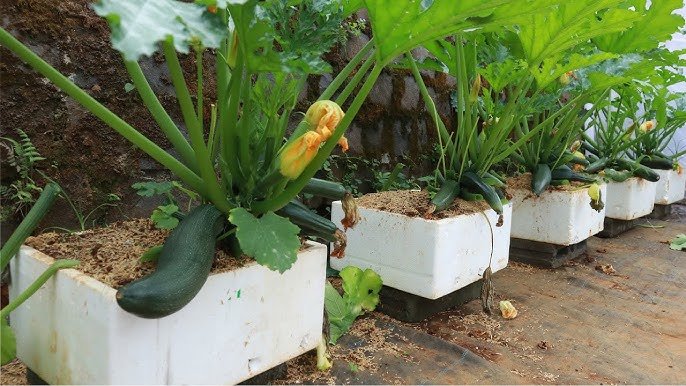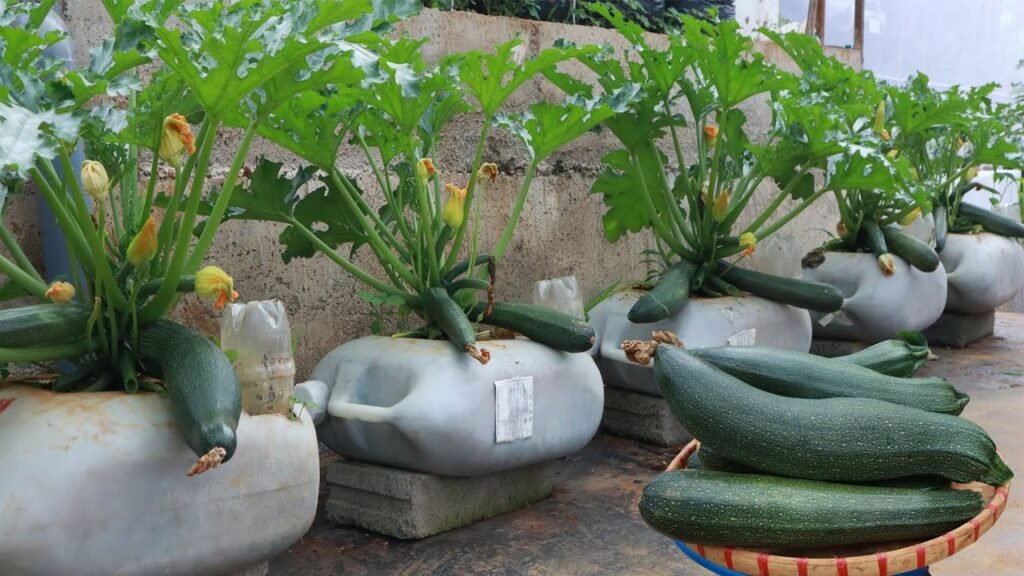Zucchini, also known as courgette, is a versatile, fast-growing vegetable that can thrive in home gardens. For gardeners with limited space, innovative methods such as growing zucchini in plastic cans offer an efficient solution. Adding a natural twist by using bananas as fertilizer can boost plant growth, increase yields, and make gardening more sustainable. In this comprehensive guide, we’ll explore step-by-step how to grow zucchini in plastic cans using bananas as fertilizer, helping you enjoy a bountiful harvest at home.
Why Grow Zucchini at Home?

Zucchini is not only delicious but also packed with essential nutrients. It is low in calories, high in fiber, and rich in vitamins such as A, C, and potassium. Home-grown zucchini is fresher, tastier, and free from harmful chemicals commonly used in commercial farming.
Benefits of Growing Zucchini at Home:
- Freshness: Pick zucchini at peak ripeness for better flavor and texture.
- Cost-Effective: Growing your own vegetables reduces grocery bills.
- Eco-Friendly: Reduces reliance on store-bought produce and encourages sustainable gardening practices.
- Fun and Educational: Ideal for beginner gardeners, teaching them about plant growth and natural fertilizers.
Why Use Plastic Cans for Gardening?

Plastic cans are an excellent choice for container gardening due to several reasons:
- Affordable and Accessible: Many households have spare plastic cans, making them ideal for gardening.
- Space-Saving: Perfect for small patios, balconies, or terraces.
- Portable: Easy to move cans to catch sunlight or protect plants from harsh weather.
- Sustainable: Repurposing cans reduces plastic waste, contributing to eco-friendly practices.
Why Bananas as Fertilizer?

Bananas are rich in potassium, phosphorus, calcium, and other nutrients essential for plant growth. Using banana peels or overripe bananas as fertilizer provides the following benefits:
- Promotes Flowering and Fruit Production: Potassium in bananas supports zucchini flowers, leading to higher yields.
- Improves Soil Health: Decomposing bananas enrich the soil with organic matter and beneficial microbes.
- Cost-Effective and Natural: Eliminates the need for chemical fertilizers, making it eco-friendly and safe for your plants.
Step-by-Step Guide to Growing Zucchini in Plastic Cans Using Bananas

1. Selecting the Right Can
Choose a plastic can that is large enough to accommodate zucchini roots. A minimum capacity of 5–10 liters is ideal. Larger cans are better, as zucchini plants can grow vigorously and require ample space for root development.
Tip: Ensure the can is clean and free from any harmful residues before planting.
2. Preparing the Can
- Drill several small holes at the bottom of the can for proper drainage.
- If the can is opaque, consider painting it light-colored to reflect sunlight and keep the soil cool.
- Place a layer of small stones or broken pot pieces at the bottom to prevent soil from clogging the drainage holes.
3. Preparing the Soil
Zucchini prefers nutrient-rich, well-draining soil. A good soil mix includes:
- 2 parts garden soil
- 1 part compost or organic manure
- 1 part coco peat or vermiculite
Mix thoroughly for proper aeration and moisture retention. Avoid compacted soil, as it can hinder root growth.
4. Adding Banana Fertilizer

Bananas can be used as natural fertilizer in several ways:
- Banana Peels: Chop peels into small pieces and mix them into the soil before planting.
- Overripe Bananas: Mash overripe bananas and mix them into the soil or bury them near the root zone.
- Banana Tea: Soak banana peels in water for 2–3 days, then use the liquid to water the plants.
Bananas enrich the soil with potassium and other essential nutrients, promoting vigorous growth and more fruiting.
5. Sowing Zucchini Seeds
- Fill the prepared can with soil, leaving 2–3 inches from the top.
- Create small holes about 1 inch deep.
- Place 2–3 zucchini seeds per hole and cover lightly with soil.
- Water gently using a watering can.
Pro Tip: Soak seeds overnight before sowing to speed up germination and improve seedling strength.
6. Choosing the Right Location
Zucchini plants require full sunlight for at least 6–8 hours a day. Place the cans in a sunny spot such as a balcony, terrace, or garden area. Adequate sunlight ensures healthy growth, abundant flowering, and higher fruit yields.
7. Watering Techniques
Even with banana fertilization, zucchini needs consistent moisture, especially during flowering and fruiting.
- Water deeply 2–3 times per week, depending on weather conditions.
- Avoid overhead watering to reduce the risk of fungal diseases.
- Mulch around the base of the plant with straw, dried leaves, or shredded coconut husk to retain moisture.
8. Supporting Zucchini Plants
Zucchini plants can grow sprawling vines. Providing support helps prevent damage and improves fruit quality:
- Use stakes, trellis, or cages to support the vines.
- Tie stems loosely with soft ties to avoid breaking.
- Regularly guide vines to spread evenly around the can.
Proper support also improves air circulation, reducing the risk of fungal infections.
9. Fertilization During Growth
In addition to bananas, supplement your zucchini plants with organic fertilizers for optimal growth:
- Compost Tea: Provides additional nutrients and beneficial microbes.
- Liquid Organic Fertilizers: Fish emulsion or diluted manure supports flowering and fruiting.
- Mulch: Maintains soil fertility and retains moisture.
Apply fertilizers every 2–3 weeks for the best results.
10. Pest and Disease Management
Zucchini plants are prone to pests like aphids, squash bugs, and powdery mildew. Organic management ensures healthy, chemical-free produce:
- Spray neem oil or insecticidal soap weekly.
- Remove affected leaves immediately to prevent disease spread.
- Use companion planting with marigold or nasturtium to naturally repel pests.
Healthy plants produce more flowers and fruits, directly increasing yield.
11. Harvesting Zucchini
Zucchini grows rapidly, and fruits can be harvested in 45–60 days, depending on the variety.
- Pick fruits when they are 6–8 inches long for the best flavor and texture.
- Harvest regularly to encourage continuous fruit production.
- Use clean hands or scissors to cut fruits, avoiding damage to the plant.
Pro Tip: Leaving zucchini on the plant too long can reduce subsequent flowering and fruiting.
Advantages of Growing Zucchini in Plastic Cans
- Space-Efficient: Perfect for small urban gardens, balconies, or terraces.
- Eco-Friendly: Repurposes plastic waste and reduces the need for chemical fertilizers.
- High Yield: With proper care and banana fertilization, zucchini plants produce abundant fruits.
- Beginner-Friendly: Simple setup and easy maintenance make it suitable for novice gardeners.
Creative Tips for Container Zucchini Gardening
- Vertical Gardening: Use hanging cans to maximize space.
- Decorative Cans: Paint cans with bright colors to enhance your garden aesthetics.
- Companion Planting: Plant basil, nasturtium, or marigold nearby to naturally deter pests.
- DIY Banana Fertilizer: Reuse all kitchen banana waste for continuous soil enrichment.
Final Thoughts
Growing zucchini in plastic cans using bananas as fertilizer is a simple, cost-effective, and sustainable way to enjoy home-grown vegetables. This method not only transforms waste into productive gardening tools but also ensures healthy, abundant zucchini with minimal effort.
By following these steps—selecting the right can, preparing nutrient-rich soil, using bananas as natural fertilizer, providing adequate sunlight, water, and support—you can achieve a thriving zucchini harvest right at home.
Start today, repurpose your plastic cans, and watch your zucchini plants flourish, providing more fruits than you ever imagined. With consistent care and eco-friendly practices, this gardening method is perfect for beginners, urban gardeners, and anyone looking to enjoy fresh, chemical-free vegetables.
